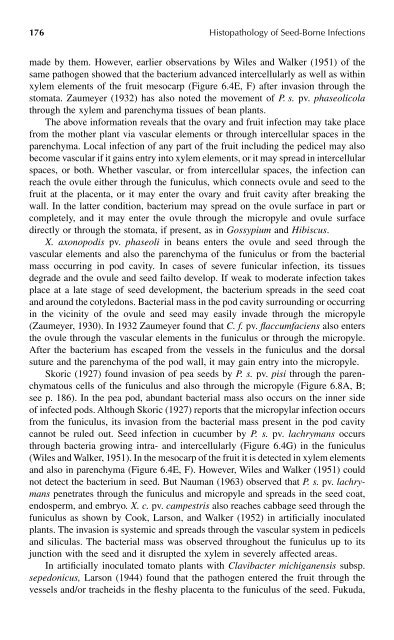Histopathology of Seed-Borne Infections - Applied Research Center ...
Histopathology of Seed-Borne Infections - Applied Research Center ...
Histopathology of Seed-Borne Infections - Applied Research Center ...
Create successful ePaper yourself
Turn your PDF publications into a flip-book with our unique Google optimized e-Paper software.
176 <strong>Histopathology</strong> <strong>of</strong> <strong>Seed</strong>-<strong>Borne</strong> <strong>Infections</strong>made by them. However, earlier observations by Wiles and Walker (1951) <strong>of</strong> thesame pathogen showed that the bacterium advanced intercellularly as well as withinxylem elements <strong>of</strong> the fruit mesocarp (Figure 6.4E, F) after invasion through thestomata. Zaumeyer (1932) has also noted the movement <strong>of</strong> P. s. pv. phaseolicolathrough the xylem and parenchyma tissues <strong>of</strong> bean plants.The above information reveals that the ovary and fruit infection may take placefrom the mother plant via vascular elements or through intercellular spaces in theparenchyma. Local infection <strong>of</strong> any part <strong>of</strong> the fruit including the pedicel may alsobecome vascular if it gains entry into xylem elements, or it may spread in intercellularspaces, or both. Whether vascular, or from intercellular spaces, the infection canreach the ovule either through the funiculus, which connects ovule and seed to thefruit at the placenta, or it may enter the ovary and fruit cavity after breaking thewall. In the latter condition, bacterium may spread on the ovule surface in part orcompletely, and it may enter the ovule through the micropyle and ovule surfacedirectly or through the stomata, if present, as in Gossypium and Hibiscus.X. axonopodis pv. phaseoli in beans enters the ovule and seed through thevascular elements and also the parenchyma <strong>of</strong> the funiculus or from the bacterialmass occurring in pod cavity. In cases <strong>of</strong> severe funicular infection, its tissuesdegrade and the ovule and seed failto develop. If weak to moderate infection takesplace at a late stage <strong>of</strong> seed development, the bacterium spreads in the seed coatand around the cotyledons. Bacterial mass in the pod cavity surrounding or occurringin the vicinity <strong>of</strong> the ovule and seed may easily invade through the micropyle(Zaumeyer, 1930). In 1932 Zaumeyer found that C. f. pv. flaccumfaciens also entersthe ovule through the vascular elements in the funiculus or through the micropyle.After the bacterium has escaped from the vessels in the funiculus and the dorsalsuture and the parenchyma <strong>of</strong> the pod wall, it may gain entry into the micropyle.Skoric (1927) found invasion <strong>of</strong> pea seeds by P. s. pv. pisi through the parenchymatouscells <strong>of</strong> the funiculus and also through the micropyle (Figure 6.8A, B;see p. 186). In the pea pod, abundant bacterial mass also occurs on the inner side<strong>of</strong> infected pods. Although Skoric (1927) reports that the micropylar infection occursfrom the funiculus, its invasion from the bacterial mass present in the pod cavitycannot be ruled out. <strong>Seed</strong> infection in cucumber by P. s. pv. lachrymans occursthrough bacteria growing intra- and intercellularly (Figure 6.4G) in the funiculus(Wiles and Walker, 1951). In the mesocarp <strong>of</strong> the fruit it is detected in xylem elementsand also in parenchyma (Figure 6.4E, F). However, Wiles and Walker (1951) couldnot detect the bacterium in seed. But Nauman (1963) observed that P. s. pv. lachrymanspenetrates through the funiculus and micropyle and spreads in the seed coat,endosperm, and embryo. X. c. pv. campestris also reaches cabbage seed through thefuniculus as shown by Cook, Larson, and Walker (1952) in artificially inoculatedplants. The invasion is systemic and spreads through the vascular system in pedicelsand siliculas. The bacterial mass was observed throughout the funiculus up to itsjunction with the seed and it disrupted the xylem in severely affected areas.In artificially inoculated tomato plants with Clavibacter michiganensis subsp.sepedonicus, Larson (1944) found that the pathogen entered the fruit through thevessels and/or tracheids in the fleshy placenta to the funiculus <strong>of</strong> the seed. Fukuda,


